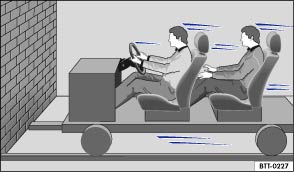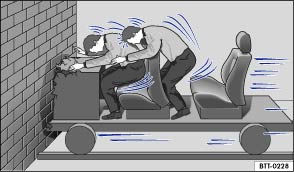Volkswagen Golf Owners Manual: Frontal collisions and the laws of physics

Fig. 59 Unbelted occupants in a vehicle heading for a brick wall

Fig. 60 Unbelted occupants in a vehicle striking a brick wall
 First read and observe the introductory information
and safety warnings 
First read and observe the introductory information
and safety warnings The physical principles involved in a frontal collision are relatively simple. As soon as the vehicle is in motion  , both the moving vehicle and its passengers gain kinetic energy.
The higher the vehicle speed and the heavier the weight of the vehicle, the greater the amount of energy that will have to be released in the event of an accident.
However, the most significant factor is the speed of the vehicle. If the speed doubles from approximately 25 km/h (15 mph) to approximately 50 km/h (30 mph), for example, the kinetic energy increases by a factor of four.
The amount of kinetic energy depends on the speed of the vehicle and the weight of the vehicle and passengers. The higher the speed and the heavier the weight, the greater the amount of energy that will be released in the event of an accident.
Passengers not wearing seat belts are not connected to the vehicle. In the event of a frontal collision they will continue to move forwards at the same speed at which the vehicle was travelling before impact, until something stops them. Because the passengers in our example are not restrained by seat belts, the entire amount of kinetic energy will only be released at the point of impact against the wall  .
Even at speeds of approximately 30 km/h (18 mph) to approximately 50 km/h (30 mph), the forces acting on bodies in a collision can easily exceed one tonne (1,000 kg). These forces are even greater at higher speeds.
This example applies not only to frontal collisions, but to all accidents and collisions.
 Warning lamp
Warning lamp
Fig. 57 Warning lamp in the instrument
cluster
Fig. 58 Seat belt status for the rear seats
in the instrument cluster
First read and observe the introductory information
and safety warnings†...
 What happens to vehicle occupants who have not fastened their seat belts
What happens to vehicle occupants who have not fastened their seat belts
Fig. 61 An unbelted driver is thrown forwards
Fig. 62 The unbelted rear passenger is
thrown forwards, hitting the belted driver
First read and observe the introductory information
and safety ...
Other materials:
Assembly overview - rear child seat anchors
1 -
ISOFIX child seat anchor
Qty. 4
Welded to underbody
2 -
Guide
For ISOFIX child seat anchor
Qty. 4
Removing and installing
→ Chapter
Must be seated firmly on child seat anchor
3 -
Li ...
Mechanically positioned ball coupling
Fig. 107 Swivelling out the ball coupling
First read and observe the introductory information
and safety warnings In the rear bumper there is a ball coupling for the towing
bracket which can be swivelled out when needed. The ball coupling cannot be removed.
Swivelling out the ball coupli ...
Removing and installing wind deflector
Special tools and workshop equipment
required
Removing
Torque wrench -V.A.G 1783-
–
Open glass panel completely.
– ...
